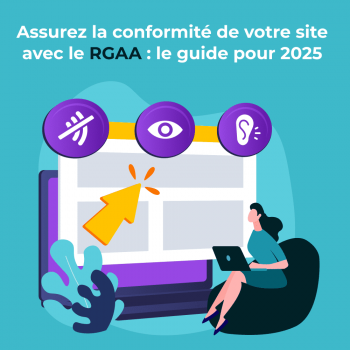How to design a site optimized for SEO?
We can't talk about it enough: our UX / UI department doesn't work behind closed doors. It is essential that our designers are immersed in all of our clients' needs in order to respond to all of their issues, both business and online service optimization.
Combining SEO and UX is called SXO (Search Experience Optimization) and is a major key to success on the internet because it combines a technical and an emotional approach.
In order to better design our models and templates, our exchanges with the Digital Marketing division of Performance and our knowledge in SEO allow us, from the design phase of the models, to include these issues in our work, for common objectives: a better referencing of your site (so that the user finds it) and a better experience on the site (so that he stays there and finds the points of transformation: purchase, contact or appointment, registration for a newsletter ...)
SEO and good practices
A good referencing is based above all on clear and quality contents and some good practices to respect in front of the requirements of the search engines. You can find all these good practices in our article "The good practices of On-Page SEO".
The UX also has a big role to play
The field of UX is, by definition, focused on the user and brings its contribution to the building on essential topics such as ease of navigation, quality of content, or a good adaptation of screens in mobile. Not only will these contributions help the site to stand out from the engines, but above all, they are decisive in capturing the user once on the site. The goal is to minimize distractions and maximize engagement.
Our UX/UI methodology optimized for SEO
Concerning our design steps, what does this mean concretely for the reflection around the information architecture and templates?
Putting ourselves in the shoes of future users, through personas, immersion in their daily lives or interviews, allows us to see more clearly their pain points, their needs/expectations and their intentions. We will see that knowing the target is crucial for the future.
Speed and mobile use: a must
Today, mobile usage has become very important (65% of searches). This means that your products / services must be ergonomically flawless on this type of device for a good experience. We also know that Google can penalize you if your site is not responsive or poorly optimized on mobile.
Concerning the page loading time, it should not take more than 3 seconds for a person to leave your site, that's why this point is so important. It is at the level of UX design that decisions impacting the loading time are taken: number and quality of images, presence of animations and parallaxes, segmentation or not of the content ...
Content hierarchy, tree structure and internal mesh
When prioritizing information in the UX workshop, we avoid overly deep tree structures so that the pages remain accessible in a few clicks and stand out well on search engines. An ideal site architecture is often simple and combines the objectives of the site and those of the user. It is important to have a menu that reflects this simplicity and the presence of a breadcrumb trail that is a complementary orientation tool to the menu.
The internal mesh is beneficial to make the navigation more fluid and keep the user on the site. We make sure that he never reaches a dead end. The internal mesh is also important to guide bots on "how to crawl the site" or to reinforce the notoriety on a specific theme. A good architecture and a good mesh guarantee a pleasant experience and a satisfactory indexing speed.
Choosing keywords and content
We are present during the research work on keywords, in order to include them in our titles and paragraphs, and we place these words above the waterline as a priority. Our user research and immersion in the client's world allows us to select words from the semantic field of the targets' activity, which may be a particular language or specific "jargon". Thinking about the different questions they may have allows us to obtain a choice of words perfectly adapted to the targets and their future research.
A good way to orientate this work is to make sure of the search intentions, which can be navigational (the user knows your site), informational (they are looking for an answer to a specific question) or transactional (they want to buy a product or a service).
Tagging, HN structure and content density
We apply the Hn cascade structure, that is, the hierarchical tags, for a better reading and understanding of your content (for Google robots and for users).
Great care is taken with the Meta-Title and Meta-Description tags because it is often the first thing we see on the search results pages: tone, integration of keywords and the right amount of words to remain visible in full.
On each page, we give priority to the quality of the texts over their quantity, while keeping in mind that a page must contain at least 500 words.
Finally, take care of the appearance of the site
Of course, our UI teams take great care of the final appearance of the site, because if it is aesthetic, pleasant, ergonomic and consistent with a brand image, it will stay there and especially will return. This is where the crucial point of loyalty comes into play. The CTAs must be well placed and visible because they are the gateway to the desired transformation actions for the different targets.
To conclude
A good SEO takes time, but to start on a good basis, you might as well include good SEO practices from the design of your site with our UX / UI pole.
In this article, we've looked at various performance-oriented UX fields of action and seen that they are complementary to in-depth work on SEO.
Combining SEO and UX strategies maximizes results and allows you to have all the cards in hand to position yourself well in a very competitive world. The first results are often seen in the medium term (about 6 months). It is therefore necessary to be patient and always be on the lookout for any form of evolution because indeed, the web evolves very quickly, just like Google's algorithms.
This joint work of SXO allows us to make the site stand out on search engines, to keep the user on the site thanks to a good experience and to reach the desired transformation. Working on one without the other would not be relevant.
To help you optimize your SEO, think about :
- Include and be open to proposals for UX improvements, with a view to a common and global SXO work
- Regularly analyze the behavior of your users in their daily life, for Ux improvements and audits on your site (number of visits, tracking ...) for SEO improvements
- Review your keyword strategy to adapt it to your users
- Couple your SXO strategies with other digital marketing levers
If you want your project to be well designed from the beginning with best practices and SEO and UX experts, don't hesitate to contact us








